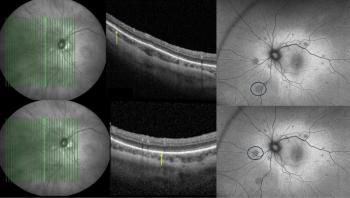
- Ophthalmology Times Europe September 2020
- Volume 16
- Issue 7
Amblyopia screening with the dynamic random dot stereotest
A new amblyopia screening system that can be used on Android devices has performed better than some of the ‘gold standard’ stereotests in recent Hungarian studies.
Amblyopia originates from abnormal early binocular visual experience due to strabismus, anisometropia or form deprivation in young childhood and is accompanied by the loss or severe impairment of binocular depth perception.1,2 In this condition, the corrected visual acuity of the suppressed eye suffers a reduction as a consequence of the associated visual cortex changes, even though no visible abnormalities are present.3
The worldwide prevalence of amblyopia is between 1 and 5%3 and is approximately three times higher in an unscreened population compared with a screened cohort.4 Unrecognised amblyopia can lead to various functional deficits of the visual system that become more difficult to treat with increasing age.5 Accordingly, there is an evident need for a reliable screening method for the condition, which also needs to be easy to perform and fast considering that it is largely needed for young children.
Since a deficit of the binocular visual function is present in amblyopia, the use of stereo vision tests has been proposed as potentially useful for amblyopia screening.6-9 However, most of the conventional stereopsis tests available on the market contain monocular cues for various reasons,10,11 and so can lead to inaccurate stereoacuity values.
Likewise, all tests have a predetermined set of stimuli displayed on a plastic or paper board which encourages motivated children to memorise expected responses. In school or kindergarten screenings, biased results can be obtained if children have an opportunity to communicate with their friends after the evaluation.
These factors have been demonstrated to affect the ratio of both the false-positive and false-negative passes.12 Stereotest disadvantages such as these create the need for more versatile tools using new technologies to be developed(e.g., tablets and smartphones) to facilitate their use.
A new concept of stereotest: Euvision
A new screening system called EuvisionTab has been developed by the University of Pécs, Hungary, and comprises software that can be used on Android devices, overcoming most of the limitations of currently available stereotests.13 Part of the system is a stereovision module, based on a random dot stereogram (RDS), which is essentially an RDS image generator with great flexibility as the parameters of the RDSs are freely adjustable (Figure 1).
It also includes a dynamic version of the RDS, which had an embedded, disparity-defined Snellen-E optotype (DRDSE) that is presented in random orientations (up, down, left or right). The orientation ofthe ‘E’ is only visible if the images are perceived binocularly through red-green anaglyph glasses (low-pass red R26 and YG09 band-pass green gelatin filters)14 and the observer has intact stereopsis.
The first version screening set of Euvision comprises a series of nine binocularly visible Snellen E letters and two monocularly visible Snellen-Es. The latter two serve as control, to check if the subjects have really understood the task and are able to identify the Snellen E orientation regardless of the existing ocular condition.
The disparity and the dot size of the images are 420 sec of arc, which is the lowest within the optimum range.15 The line thickness of the Snellen E optotype subtends 2° of visual angle from the 25–30 cm viewing distance.
The dot density of the images is 1%, with 3% uncorrelated noise. Images are updated at 10 Hz. Before the presentation of the nine + two DRDSE, eight other, easier-to-practice RDS images are shown to enable the user to become familiar with the task and the stimuli. These RDS images arecomposed of either static (non-refreshing) dots, or they have larger disparities and a higher dot density.
Euvision is under constant development, with regular clinical validation of the newer screening sets taking place. Once the product is commercialised, its users will always be provided with the upgrade of the most efficient state-of-the-art vision screening methods.
The screening system can also be used to perform a remote examination by using different video conference programmes (e.g., Skype, Zoom, Microsoft Teams, Cisco Webex, etc.) The only requirement is that the anaglyphic glasses should be passed to the patient prior to the date of examination.
After sharing the examination screen, the stereo vision test can be conveniently carried out with the video guidance of the examiner. Limitation of the frame rate in dynamic RDSs can occur due to insufficient internet bandwidth but static RDS can be applied with no problems.
First clinical validation
A clinical study was conducted with the Euvision system at the Department of Ophthalmology of the University of Pécs to define its sensitivity and specificity for amblyopia detection and also for the detection of other visual conditions.13 Specifically, our DRDSE test (presented on version 10.1 of a Samsung Galaxy tablet) was compared with the Lang II stereotest in a sample of 141 children (aged 4–14 years; mean age 8.9).
In this series, DRDSE was found to have better sensitivity than Lang II for the detection of amblyopia (100% versus 81.8%), convergent strabismus (100% versus 80.9%) and uncorrected (75% versus 52.8%). The specificity of DRDSE was 61.2%, 67.3% and 68.6% for amblyopia, strabismus and hyperopia, respectively, whereas these values were somewhat better for Lang II (73.8%, 79.2% and 77.9%, respectively).
Significant improvements were introduced in the EuvisionTab system before a second clinical trial took place. Now, the frame rate can be precisely maintained constantly regardless of the type of hardware used; it can be adjusted between 1 and 60 Hz. The dot arrangement became insensitive to the quality of anaglyphic filters, and no monocular cues are visible even if commercial paper glasses are used.
Second clinical validation
The second clinical study was conducted at the Department of Ophthalmology of the Vithas Medimar Hospital, Alicante, Spain, in 473 children (aged 4–14 years). Good sensitivity and specificity for the detection of amblyopia were obtained using different dot density and pass/fail criterion for the DRDSE test in this larger sample (100% and 81%).
With the Lang II system, sensitivity was only 48.4%, with a specificity of 98%. More detailed results of the study will be published soon.
Conclusion
The DRDSE test with the latest improvements in dot density and pass/fail criteria is a valuable tool for amblyopia screening and gives a better performance than other tests considered as the gold standard for screening. The test is very sensitive and specific enough for the detection of amblyopia in children.
The main advantages are that the test is performed in only 5 min (including the explanation of the task to the children) and is easy to use (after a short amount of training) for non-professional examiners such as teachers, parents, district nurses or social workers. As for the technical requirements, a tablet or mobile phone with the appropriate software and red-green spectacles are required.
More studies are being conducted to evaluate the recent improvements that have been made to the test in large samples as well as to analyse its diagnostic performance for other visual conditions.
---
Admed Harmouche, MD
András Czigler, MD
Gábor Jandó, MD, PhD
László Závori, MD, FRCEM, MSc
István Szabó, MD, PhD
Eszter Mikó-Baráth, MD, PhD
David Piñero, PhD
E: [email protected]s
Prof. Jandó, Dr Czigler, Dr Harmouche, Prof. Szabó and Dr Závori are based at the University of Pécs Medical School in Pécs, Hungary and are also software/ computer engineers at Euvision Ltd. Prof. Mikó-Baráth is based at the University of Pécs Medical School. Prof. Piñero is based at the Department of Optics, Pharmacology and Anatomy, University of Alicante, Spain. Prof. Jandó is CEO of Euvision; none of the other authors have any financial interests.
---
References
- McKee SP, Levi DM, Movshon JA. The pattern of visual deficits in amblyopia. J Vis. 2003;3:5.
- Webber AL, Wood J. Amblyopia: prevalence, natural history, functional effects and treatment. Clin Exp Optom. 2005;88:365-375.
- Holmes JM, Clarke MP. Amblyopia. Lancet. 2006;367:1343-1351.
- Polling JR, Loudon SE, Klaver CC. Prevalence of amblyopia and refractive errors in an unscreened population of children. Optom Vis Sci. 2012;89:e44-49.
- Hernández-Rodríguez CJ, Piñero DP. Active vision therapy for anisometropic amblyopia in children: a systematic review. J Ophthalmol. 2020. https://doi.org/10.1155/2020/4282316.
- Julesz B, Kropfl W, Petrig B. Large evoked potentials to dynamic random-dot correlograms and stereograms permit quick determination of stereopsis. Proc Natl Acad Sci. 1980;77:2348-2351.
- Simons K, Moss A. A dynamic random dot stereogram-based system for strabismus and amblyopia screening of infants and young children. Comput Biol Med. 1981;11:33-46.
- Ehrlich MI, Reinecke RD, Simons K. Preschool vision screening for amblyopia and strabismus. Programs, methods, guidelines, 1983. Surv Ophthalmol. 1983;28:145-163.
- Newman DK, Hitchcock A, McCarthy H, Keast-Butler J, Moore AT. Preschool vision screening: outcome of children referred to the hospital eye service. Br J Ophthalmol. 1996;80:1077-1082.
- Hahn E, Comstock D, Durling S, et al. Monocular clues in seven stereotests. Dalhousie Med J. 2010;37:44.
- Serrano-Pedraza I, Vancleef K, Read JC. Avoiding monocular artifacts in clinical stereotests presented on column-interleaved digital stereoscopic displays. J Vis. 2016;16:13.
- Farvardin M, Afarid M. Evaluation of stereotests for screening of amblyopia. Iran Red Crescent Med J. 2007;9:5.
- Budai A, Czigler A, Mikó-Baráth E, et al. Validation of dynamic random dot stereotests in pediatric vision screening. Graefes Arch Clin Exp Ophthalmol. 2019;257:413- 423.
- Markó K, Kiss HJ, Mikó-Baráth E, et al. Contrast independence of dynamic random dot correlogram evoked VEP amplitude. J Vis. 2009;9:8.
- Horvath G, Nemes VA, Rado J, et al. Simple reaction times to cyclopean stimuli reveal that thebinocular system is tuned to react faster to near than to far objects.PLoS One. 2018.https://doi.org/10.1371/journal.pone.0188895
Articles in this issue
about 5 years ago
Monitoring blood reflux during gonioscopy in glaucomaNewsletter
Get the essential updates shaping the future of pharma manufacturing and compliance—subscribe today to Pharmaceutical Technology and never miss a breakthrough.













































